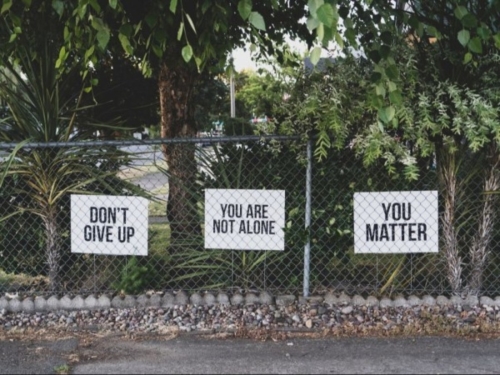
Freedom, Safety and the Role of Leadership in Suicide Prevention
We need to talk.
We want to highlight a crucial matter that not only impacts the wellbeing of your employees but also directly affects the success and reputation of your organisation. As an organisation working with HR professionals, we have a commitment to mental health and a wealth of personal experience of its challenges. We are deeply passionate about creating a workplace culture that prioritises the mental wellbeing of employees. Specifically, we want to shed light on the pressing issue of suicide prevention in the workplace. By addressing this topic head-on and implementing effective measures, we can solidify our commitment to our employees and cultivate an environment of trust, support, and success.
‘It's shocking but not surprising that the cost of poor mental health to employers is now up to a huge £56 billion per year.’ - Emma Mamo, Head of Workplace Wellbeing at Mind
In the United Kingdom, mental health awareness has been on the rise, and rightly so. Our society is beginning to recognise that mental health is just as important as physical health, especially post-pandemic. This awareness extends to the workplace, where employees spend a significant portion of their lives. As someone who has faced mental health challenges personally, I can attest to the impact of a supportive workplace environment. Being a part of an organisation that provides me with a safe space to talk, professional mental health support and a willingness to adapt, has allowed me to better take charge of my own mental health, allowing me to thrive. That's why I feel compelled to emphasise the importance of suicide prevention in the workplace.
Suicide prevention isn't just a responsibility for healthcare professionals. It's a collective duty that extends to all aspects of society, including the workplace. Your people are your most valuable assets. To ensure they feel safe, which is one of the key neuroscience areas to fulfil happiness, they must work in an environment that facilitates emotional safety, such as freedom from bullying, prejudice or psychological abuse. Addressing suicide prevention in the workplace goes beyond fulfilling a legal obligation; it's about demonstrating genuine concern for the wellbeing of every individual who contributes to your organisation's success.
The foundation of effective suicide prevention lies in cultivating a culture of openness and freedom. Employees should feel comfortable discussing their mental health challenges without fear of judgement or repercussion. In order to achieve this, you must ensure your culture facilitates the ‘3 As’ - Acceptance, Authenticity and Autonomy. And as with most workplace change, leaders must lead by example. Sharing their commitment to mental wellbeing, expressing empathy, and actively listening can set the tone for open communication. This sends a powerful message that seeking help is not a sign of weakness but a courageous step toward wellbeing.
One of the most impactful ways to prevent suicide in the workplace is through education and training. By encouraging growth and empowering employees and managers with the necessary tools and knowledge, we give everyone the tools to recognise warning signs and offer appropriate support. Mental health first aid courses, seminars, and resources can equip your workforce to understand the importance of seeking help and reaching out to colleagues who may be struggling.
It's vital to provide easy access to mental health resources and enable your people to find help. Just as we have first aid kits for physical injuries, we should have mental health resources readily available - here is a list of our own we created for this purpose. Employee assistance programs (EAPs), helplines, and online platforms can serve as invaluable resources for those in need. These resources not only offer guidance but also emphasise that your organisation is committed to supporting mental health at all levels.
The stigma surrounding mental health issues is one of the biggest barriers to seeking help. By actively working to reduce this stigma, we create an environment where individuals feel comfortable discussing their struggles without fear of discrimination. This will ensure they feel safe which is a precursor to feeling happier in the workplace. Promoting mental health as a normal part of life and celebrating stories of resilience can significantly contribute to dismantling the stigma associated with it.
As leaders, it's your responsibility to be attuned to the wellbeing of your team members. Recognising warning signs of potential distress, such as withdrawal, changes in behaviour, or a decline in work performance, can enable early intervention and potentially save a life.
An effective way to do this is to create a listening strategy to highlight problems and follow up with specialised surveys such as our Employee Mental Health Survey.
Talking about suicide
Joking about suicide
Using language like ‘feeling like a burden’ ‘people would be better off without me’ ‘I feel trapped.’ ‘Sometimes I wish I wouldn't wake up in the morning.’ ‘There's no way out.’
An ‘overnight recovery’ i.e. being unwell/low for months but over a couple of days/weeks they appear “back to normal”
Unexpectedly talking about getting their affairs in order - financial, will etc.
Giving their belongings away as gifts
Random declarations of love or making amends and reconciling with people.
Complete social withdrawal
Escalating risk-taking behaviour
Change in mood (agitated), eating, sleeping habits etc
Establishing a clear protocol for addressing concerns and providing support is essential to ensuring that no employee feels alone in their struggles. Here is a one-day training course on suicide first aid. It will help you prevent and understand suicide through suicide intervention.
While we can take significant strides in promoting mental wellbeing within an organisation, it's important to acknowledge that we are not mental health experts. Collaborating with mental health professionals and organisations can enrich our efforts. Partnering with external experts can ensure that any initiatives put in place are evidence-based and aligned with the latest best practices in the field.
Overall, creating a workplace that prioritises suicide prevention and mental wellbeing is not just an ethical obligation; it's a strategic imperative. By cultivating a culture of openness, providing education and resources, and actively addressing stigma, we can empower employees to seek help when needed and ultimately contribute to a happier, healthier, and more productive workforce. A commitment to suicide prevention not only shapes the lives of your employees but also the reputation and success of your organisation.
For immediate support call the Samaritans for free on 116 123 or visit their website.

Linked to Happiness in our neuroscience methodology... learn more
The Happiness Index helps organisations measure the key employee engagement AND happiness drivers to power their people strategy.
Our unique platform offers the products, insights and tools to shine a light on your cultural health and empower management to drive thriving cultures.
Our neuroscience-based pre-built surveys measure the full employee experience - from onboarding to exit to empower and enable organisations to understand their people and create data-led action plans.
